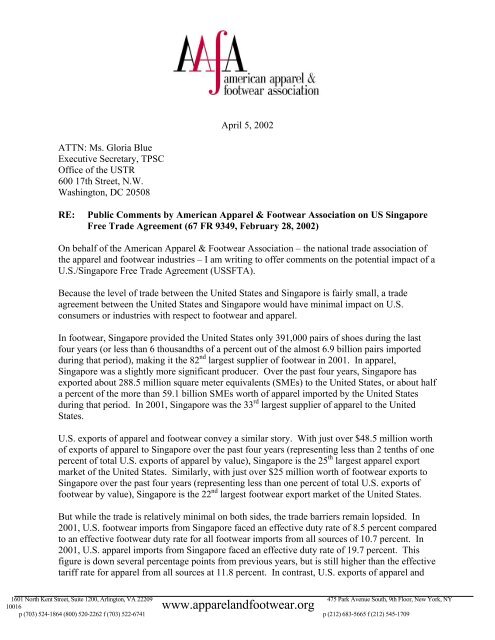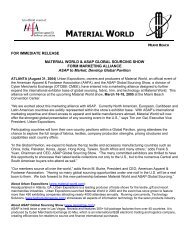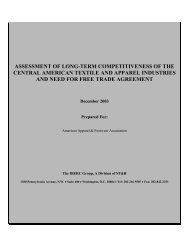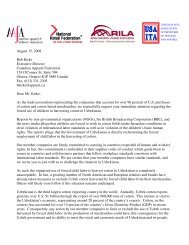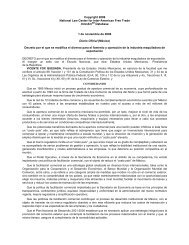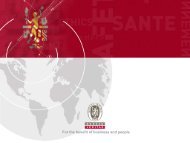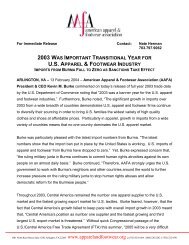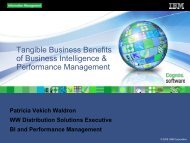U.S.-Singapore Free Trade Agreement (FTA)
U.S.-Singapore Free Trade Agreement (FTA)
U.S.-Singapore Free Trade Agreement (FTA)
You also want an ePaper? Increase the reach of your titles
YUMPU automatically turns print PDFs into web optimized ePapers that Google loves.
April 5, 2002ATTN: Ms. Gloria BlueExecutive Secretary, TPSCOffice of the USTR600 17th Street, N.W.Washington, DC 20508RE:Public Comments by American Apparel & Footwear Association on US <strong>Singapore</strong><strong>Free</strong> <strong>Trade</strong> <strong>Agreement</strong> (67 FR 9349, February 28, 2002)On behalf of the American Apparel & Footwear Association – the national trade association ofthe apparel and footwear industries – I am writing to offer comments on the potential impact of aU.S./<strong>Singapore</strong> <strong>Free</strong> <strong>Trade</strong> <strong>Agreement</strong> (USS<strong>FTA</strong>).Because the level of trade between the United States and <strong>Singapore</strong> is fairly small, a tradeagreement between the United States and <strong>Singapore</strong> would have minimal impact on U.S.consumers or industries with respect to footwear and apparel.In footwear, <strong>Singapore</strong> provided the United States only 391,000 pairs of shoes during the lastfour years (or less than 6 thousandths of a percent out of the almost 6.9 billion pairs importedduring that period), making it the 82 nd largest supplier of footwear in 2001. In apparel,<strong>Singapore</strong> was a slightly more significant producer. Over the past four years, <strong>Singapore</strong> hasexported about 288.5 million square meter equivalents (SMEs) to the United States, or about halfa percent of the more than 59.1 billion SMEs worth of apparel imported by the United Statesduring that period. In 2001, <strong>Singapore</strong> was the 33 rd largest supplier of apparel to the UnitedStates.U.S. exports of apparel and footwear convey a similar story. With just over $48.5 million worthof exports of apparel to <strong>Singapore</strong> over the past four years (representing less than 2 tenths of onepercent of total U.S. exports of apparel by value), <strong>Singapore</strong> is the 25 th largest apparel exportmarket of the United States. Similarly, with just over $25 million worth of footwear exports to<strong>Singapore</strong> over the past four years (representing less than one percent of total U.S. exports offootwear by value), <strong>Singapore</strong> is the 22 nd largest footwear export market of the United States.But while the trade is relatively minimal on both sides, the trade barriers remain lopsided. In2001, U.S. footwear imports from <strong>Singapore</strong> faced an effective duty rate of 8.5 percent comparedto an effective footwear duty rate for all footwear imports from all sources of 10.7 percent. In2001, U.S. apparel imports from <strong>Singapore</strong> faced an effective duty rate of 19.7 percent. Thisfigure is down several percentage points from previous years, but is still higher than the effectivetariff rate for apparel from all sources at 11.8 percent. In contrast, U.S. exports of apparel andwww.apparelandfootwear.org1601 North Kent Street, Suite 1200, Arlington, VA 22209 475 Park Avenue South, 9th Floor, New York, NY10016p (703) 524-1864 (800) 520-2262 f (703) 522-6741 p (212) 683-5665 f (212) 545-1709
footwear to <strong>Singapore</strong> during 2001, valued at $48.5 million and $25 million, respectively, facedno duties upon entry into <strong>Singapore</strong>.Given the prevalence of other sourcing options around the world, we do not anticipate <strong>Singapore</strong>becoming a significant supplier of apparel or footwear in the coming years, even under aUSS<strong>FTA</strong>. Moreover, given <strong>Singapore</strong>’s limited market and distance, we also do not envision itemerging as a significant market for U.S. exports of apparel and footwear (although we dobelieve there are opportunities for increased sales in <strong>Singapore</strong> of U.S. branded clothing andshoes produced and exported from other countries).Nevertheless, a well-constructed USS<strong>FTA</strong> does hold some possibility of generating increasedtrade between the two countries. Although such trade would be minimal when compared to totalU.S. trade flows in apparel and footwear, it would likely be greater than current bilateral tradelevels.For the USS<strong>FTA</strong> to be commercially meaningful, it should reflect a rule of origin that is bothsimple and flexible. We have previously submitted comments urging rules of origin for appareland footwear for the USS<strong>FTA</strong> and for other free trade areas that reflect these principles. At thesame time, we support inclusion in the USS<strong>FTA</strong> of provisions to protect intellectual propertyrights and facilitate trade through transparent and commonsense customs procedures.AAFA appreciates the opportunity to submit these comments. Please contact me if you have anyquestions.Sincerely,Stephen LamarSr. Vice President


